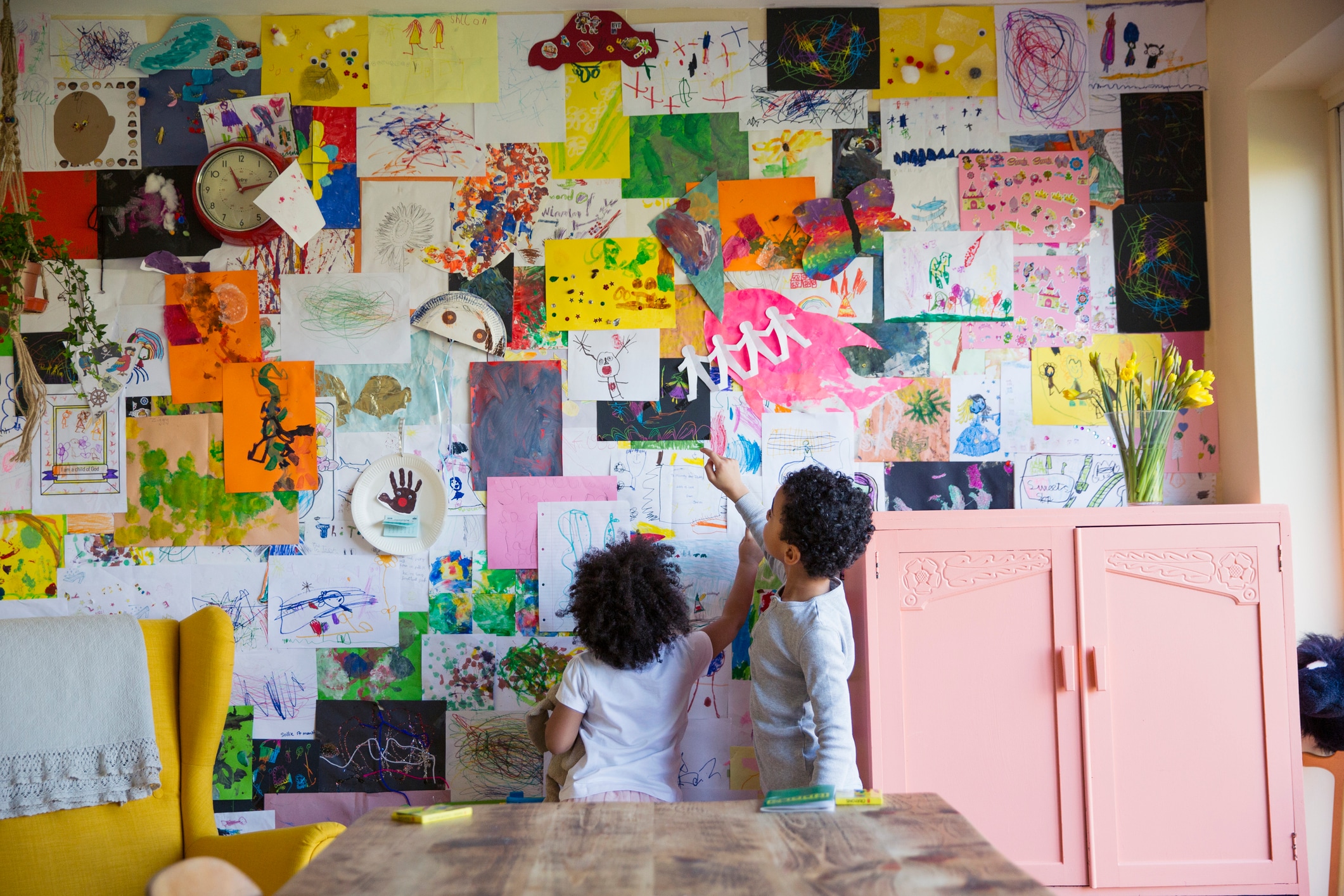In this article
If you’ve ever bought a dollhouse for your son, or allowed your daughter to play football, you’ve participated to some degree in gender creative parenting, perhaps even without knowing it. Gender creative parenting is essentially the practice of raising children outside of typical gender roles. This means granting them full autonomy to decide what they like and dislike, with no real regard to labels like “boy” or “girl.”
Allowing your child to be gender creative is to allow them to express themselves freely, and without judgment. The idea is that this will in turn help them to feel fully supported in their own eventual gender expression. While gender creative parenting has seen more popularity in recent years thanks to TikTok and Instagram, the practice itself has always existed to some degree in some households.
Key takeaways
- Gender creative parenting lets kids grow without gender stereotypes, supporting their unique interests and identity.
- It uses neutral language, diverse toys and open expression.
- Experts say it builds confidence and self-acceptance.
What is gender creative parenting?
Dr. Christia Spears Brown, a developmental psychologist and author of “Unraveling Bias” and “Parenting Beyond Pink and Blue,” defines gender creative parenting simply as, “throwing gender stereotypes out the window and focusing on your kids’ unique characteristics.”
Anyone you speak to about gender creative parenting (including Brown) will tell you that there is no textbook definition for what it is. The practice is also sometimes called “gender responsive parenting” as well as “gender neutral parenting,” but ultimately, it’s all semantics. Brown says she prefers to call it gender creative parenting.
“(It) suggests you’re being active in the process,” she says. “If you want to raise kids with fewer gender stereotypes … then you also have to help kids counter all of the gendered messages that they’re receiving from the broader society.”
How do you raise a child without gender roles?
“Let (kids) know gender is diverse, beyond binary,” says Brown. One way to do this is simply via the language we use.
Use gender neutral language
“Being mindful of how often we use gender and how we talk about other people is a thing that parents of even infants can do. Instead of saying ‘Oh, there’s the man going down the sidewalk,’ saying ‘There’s a person going down the sidewalk,’ because we don’t know that person’s gender,” she says. “So just taking gender out of our regular language, unless it’s really relevant to that particular sentence, but often we find it’s not.”
“Being mindful of how often we use gender and how we talk about other people is a thing that parents of even infants can do.”
— Dr. Christia Spears Brown, developmental psychologist and author
Don’t worry about gender labels on clothing
Not labeling clothes is another step Brown recommends in terms of gender creative parenting. For example, a trip to a department store’s boys and girls sections can be turned into a learning opportunity.
“Talk with kids about that: ‘Oh it’s a shame that they have this separated as to boys or girls because those are clothes and anybody can wear them’,” she says. “It’s a pretty small conversation. But it’s really helping your kids realize that the binary world that they see is not the only option.”
Choose non-gendered toys
With younger kids, Brown recommends being mindful of having a wide variety of toys that focus on positive traits, such as fostering creativity or athleticism. “Dolls are great because they teach nurturing and caring,” she says, adding, “be mindful though, of things like sexualized dolls, which are really common even for young kids.”
Celebrate and learn about gender diversity
Talking about gender identity with kids and celebrating different identities is important. Here are some resources for parents and family to check out:
- “The Gender Creative Child: Pathways for Nurturing and Supporting Children Who Live Outside Gender Boxes Paperback” by Diane Ehrensaft, PhD
- Raising Zoomer by Dr. Kyl Myers
- Queer Kid Stuff
- Rainbow Parenting Podcast
- Let Toys Be Toys
- Dr. Kristyn Sommer (TikTok)
Remember, it’s never too late to start
It’s never too late to begin practicing gender creative parenting. If you have older kids, Brown recommends simply helping kids navigate all the ways kids will become “gender enforcers” around them. For example, you can help them find language to challenge a classmate who says a certain activity is only for one gender, when it can clearly be for anyone.
What gender creative parenting is like in practice
What gender creative parenting looks like varies from household to household. For Lauren Eichar, a wedding photographer in Marin, California, it means providing an “expansive world of colors, toys, activities and opportunities” for her 7-month-old child, Avett.
“The biggest step we’ve taken to create a safe and supportive space for them is getting our friends and family on board with gender creative parenting,” she says. Eichar and her husband Jamie also use they/them pronouns for their child.
“The biggest step we’ve taken to create a safe and supportive space for them is getting our friends and family on board with gender creative parenting.”
— Lauren Eichar, photographer and parent
Deciding not to reveal the sex or assign a gender is another way many parents practice gender creative parenting, though it’s not a requirement. Julia R., a data specialist in San Gabriel, California, says they and their wife De’Andrea kept the sex of their baby private until they were born and used gender neutral pronouns on social media.
“I started getting really weirded out by the obsessive nature of people wanting to know the sex of our baby because it all boils down to their genitalia and why does it matter?” says Julia. For Julia, gender creative parenting has also meant being intentional about how they dress their 16-month-old, shirking gender stereotypes. “Now that she’s 16 months, they’re starting to show preferences, and it’s important that we respect those preferences,” they say.
Sometimes parents begin to practice gender creative parenting before they’ve ever heard the term, as was the case for home healthcare and hospice worker Lynn Stovall. “I am nonbinary, and I wanted to raise my child free to express themself and fully able to explore who they are and not have to fight gender roles/norms and stereotypes as a young child,” says Stovall.
For Stovall, gender creative parenting involves allowing individuals to freely explore self expression, using they/them pronouns for children until they choose their own pronouns, not making assumptions about people based on genitals or appearance, as well as allowing toys and clothing of all kinds. “And (using) terms like kid, child or baby instead of girl/boy.”
“I wanted to raise my child free to express themself and fully able to explore who they are and not have to fight gender roles/norms and stereotypes as a young child.”
— Lynn Stovall, home healthcare/hospice worker and parent
What are some of the benefits of gender creative parenting?
The benefits of gender creative parenting start early but can last throughout your child’s life.
“This reflective affirmation of identity can lead to an increased sense of authenticity, agency, self-acceptance and joy — as well as a positive and honest relationship to family,” says Ley David Elliot Cray, an educator and consultant specializing in gender, sexuality, and relationship diversity in a neuroinclusive framework.
“This reflective affirmation of identity can lead to an increased sense of authenticity, agency, self-acceptance and joy — as well as a positive and honest relationship to family.”
— Ley David Elliot Cray, scholar and LGBTQIA+ programming director
Cray says having even one affirming adult in a child’s life can reduce the likelihood of suicidality by up to 40%. “Gender creative parenting can help foster these affirming contexts, creating spaces in which our children have the ability to question, reflect, explore and affirm who they are,” says Cray.
Parents like Stovall have also shared that they are seeing gender creative parenting paying off. “To see confident children freely playing, learning and growing is incredible,” says Stovall.
Are there any downsides to gender creative parenting?
“A sad reality is that gender creative parenting is likely to turn heads,” says Cray. “For people harboring transphobic or otherwise invalidating attitudes, the gender creative parent (and, sadly, sometimes child) can become a target of ridicule or worse.”
Talking to your kids about these reactions is important. Even more important is giving them language to process and respond, as well as ensuring kids feel supported and safe.
“Even if it’s well meaning, oftentimes, people have questions,” adds Brown. She offers the example of a grandparent or teacher making a negative comment. “I think it’s alright to say, you know, ‘Grandma’s confused about this,’” she says, adding that parents can add their own explanations to fill in the gaps. “Help kids realize that other adults can be misinformed.”
Cray believes that as gender creative parenting becomes more common and familiar, pushback will slowly fade. This actually happened with Julia and their family. For the first year of their child’s life, their family members would gift highly gendered items to their child.
“I think it’s clear now that we don’t like that and they try to be more mindful,” says Julia.
Is gender creative parenting right for you?
Now that you know more about gender creative parenting, you might wonder if it’s the right choice for your family. While there’s no right or wrong answer, it’s clear that many parents find it to be a great fit. “We love that gender creative parenting doesn’t have to look one way,” says Eichar. “Anyone can find their own version of it that feels right to them.”
“We love that gender creative parenting doesn’t have to look one way. Anyone can find their own version of it that feels right to them.”
— Lauren Eichar
“Kids are capable of making choices and they are people, just like adults. Why limit them?” asks Julia.
And for parents who wonder about outsider reactions, Stovall adds this: “Remember, you owe no one an explanation about how you choose to parent your incredible little human!”





